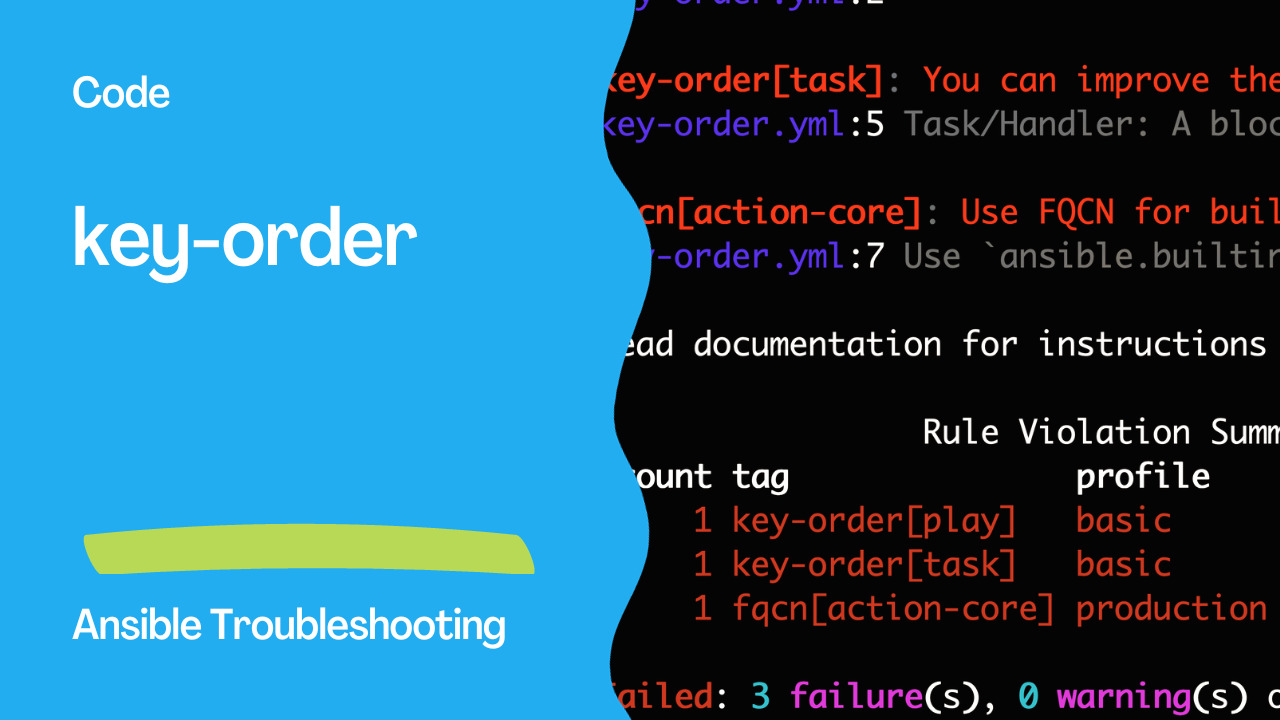Ansible Playbook key-order: Keeping Your Playbooks Neat and Error-Free
In the world of Ansible, maintaining well-structured and readable playbooks is essential. The key-order rule is your secret weapon for keeping your playbooks clean and less prone to errors. This rule offers key reordering recommendations to enhance your Ansible coding skills and streamline your playbook development.
The Anatomy of key-order
The key-order rule comes with some essential guidelines:
"
name" Comes First: For plays, tasks, and handlers, the “name” key should always be the first one. This naming convention helps you quickly grasp the purpose of a specific block of code."
block," “rescue,” and “always” Are Last: In tasks, the “block,” “rescue,” and “always” keys should be positioned at the end. This arrangement reduces the likelihood of accidental misindentation errors, especially when dealing with complex playbooks.
Spotting the Problem
Let’s take a look at a problematic code snippet:
---
- hosts: all
name: This is a playbook # <-- "name" key should be the first one
tasks:
- name: A block
block:
- name: Display a message
ansible.builtin.debug:
msg: "Hello world!"
when: true # <-- "when" key should be before "block"
Here, we encounter a playbook where the “name” key isn’t at the beginning, and the “when” key appears after the “block” key, violating the key-order rule.
Ansible Lint Output
WARNING Listing 3 violation(s) that are fatal
key-order[play]: You can improve the play key order to: name, hosts, tasks
key-order.yml:2
key-order[task]: You can improve the task key order to: name, when, block
key-order.yml:5 Task/Handler: A block
fqcn[action-core]: Use FQCN for builtin module actions (debug).
key-order.yml:7 Use `ansible.builtin.debug` or `ansible.legacy.debug` instead.
Read documentation for instructions on how to ignore specific rule violations.
Rule Violation Summary
count tag profile rule associated tags
1 key-order[play] basic formatting
1 key-order[task] basic formatting
1 fqcn[action-core] production formatting
Failed: 3 failure(s), 0 warning(s) on 1 files. Last profile that met the validation criteria was 'min'.

The Correct Order
Let’s rectify the previous example and adhere to the key-order rule:
---
- name: This is a playbook
hosts: all
tasks:
- name: A block
when: true
block:
- name: Display a message
ansible.builtin.debug:
msg: "Hello world!"
Now, we have reordered the keys according to the key-order rule recommendations.
Why Does key-order Matter?
The key-order rule is not about arbitrary rules but rather a best practice. Here’s why it’s essential:
1. Code Maintenance:
Properly ordered keys make your playbooks more accessible to read and understand, especially for large and complex scripts. When your playbook grows in complexity, you’ll appreciate the consistency in key ordering.
2. Error Prevention:
Correct key ordering reduces the chances of misindentation errors. It keeps the essential keys in predictable locations, minimizing the risk of misplaced keys and accidental mistakes.
3. Rule Evolution:
The key-order rule is not set in stone. It’s designed to evolve as the community gathers more evidence on optimal key ordering. It starts with simple guidelines like “name first” and expands as better practices emerge.
4. Playbook Resilience:
By adhering to key ordering, you ensure that your playbooks are robust and adaptable. key-order maintains the playbook’s resilience when tasks are moved or modified within the script.
A Note on Automation
The key-order rule doesn’t just recommend; it can automatically fix the key ordering using the ansible-lint --fix option. This means that you can effortlessly adhere to this rule without manual reordering, fostering consistency and adherence to best practices in your Ansible code.
Conclusion
In conclusion, the key-order rule in Ansible is your ally in creating well-structured, error-free playbooks. By following this rule, you enhance the readability of your code, reduce the likelihood of errors, and ensure that your playbooks remain resilient as they evolve. It’s not just a set of arbitrary guidelines; it’s a best practice that grows with the Ansible community’s collective wisdom.
Adhering to the key-order rule not only benefits you but also anyone who collaborates with your Ansible projects. It streamlines the development process and promotes code consistency, making it easier for your team to maintain and extend playbooks.
With automation capabilities to automatically enforce this rule, Ansible ensures that your playbooks are not only functional but also structured in a way that reflects best practices. So, the next time you dive into Ansible playbook development, keep the key-order rule in mind to maximize your efficiency and produce high-quality, maintainable code. Happy Ansible coding!
Academy
Learn the Ansible automation technology with some real-life examples in my
Udemy 300+ Lessons Video Course.

My book Ansible By Examples: 200+ Automation Examples For Linux and Windows System Administrator and DevOps

Donate
Want to keep this project going? Please donate
